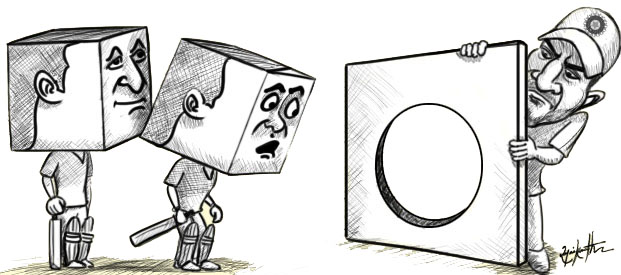 Selection meetings are supposed to be routine affairs, especially when you are two-something months away from a tournament like the 2016 World T20. The usual humdrum was expected at the last such gathering as well, despite skipper MS Dhoni arriving late. But then, the meeting lasted for over an hour, indicating something was up.
Selection meetings are supposed to be routine affairs, especially when you are two-something months away from a tournament like the 2016 World T20. The usual humdrum was expected at the last such gathering as well, despite skipper MS Dhoni arriving late. But then, the meeting lasted for over an hour, indicating something was up.
BCCI vice-president Anurag Thakur has a penchant for theatrics, and his opening sentence of ‘some breaking news for you’ didn’t help matters. Had Dhoni come in to surrender his ODI captaincy, concentrating only on the shortest format? After all, it was just about a year ago when he had given up the Test format in Australia. The setting was eerily familiar.
Instead, Dhoni was announced as the captain of the Indian team, at least until the end of the World T20. This wasn’t breaking news, not in the context of present-day journalism. At worst, it ended all speculation for the next three months. Go find your juicy fodder elsewhere, was the order.
At best, it made for some angry debate on whether the decision was the right one, considering how India’s fortunes have plummeted since the high of a semi-final finish in the 2015 ODI World Cup. Yes, it was a high point, simply because this Indian team was never in the running for the ultimate prize, when compared to Australia and New Zealand. That debate is over, and at present it is more about what happened in that tournament’s aftermath.
“
Losses to Bangladesh (in Bangladesh) and South Africa (at home) do not make comfortable reading for Dhoni the skipper, especially at a time when Virat Kohli is scaling heights in the Test arena. While the BCCI has dictated no change in captaincy yet, it makes one wonder if this was indeed the right moment for a change of leadership in the ODI format. And if not, what possibly could be the reason, since chief selector Sandeep Patil made amply clear that the situation post the World T20 will be assessed again.
”
As it turns out, there is a good enough reason. Thanks to India’s poor limited-overs form in the past nine months, both the ODI and T20I sides bear a very unsettled look. There are teething problems across the board – the openers are not in sync, the batting order is a mess, there are no finishers as the current ones (read Suresh Raina) are out of form, new faces haven’t got a look-in, and the less said about the bowling attack the better. Captaincy, as such, is the least of the selectors’ problems here.
Therefore, it is easy to understand how Dhoni survived. Yet, study the team sheets and it can be understood what transpired. The selectors got their way in getting fresh names into the ODI set-up, and thus continuing to plan for the future. Names like Manish Pandey, Gurkeerat Singh Mann and Rishi Dhawan are certain to get a go in the playing eleven, thanks to the omission of Stuart Binny and Raina from the ODI squad.
But look up the T20 squad list, and the compromise becomes clearer. When Patil outlined that the purpose of this Australian tour is to try out as many players as possible, his words ring true considering that 21 different names make up the two squads. Part of it stems from the Indian team’s unsettled look; the rest, from the team management’s point of view of giving the golden oldies one last go.
Yuvraj Singh has shown form in this domestic season, as has Harbhajan Singh. Then there is Ashish Nehra, whose fitness is fast becoming synonymous with the onset of the T20 season. There can be some argument about their statistics, both in favour and against, but the underlying question is this: In a country that boasts of arguably the best T20 league (and another uncelebrated one), isn’t there enough fresh blood to prepare for a World T20?
If Hardik Pandya can be given a run-in, why can’t Pandey, Mann and Dhawan be afforded the same opportunity in the T20s? If they can be on trial to rebuild the ODI side in the long run, why can’t they be picked for the T20 side for the immediate future?
What is the need to look back at the past? In that respect, what will three T20Is in Australia tell us, even if the oldies do succeed there? The argument herein can be that if they fail, there are enough matches to come before the World T20 (Asia Cup and probable series against Sri Lanka and West Indies) to look at the youngsters, should this idea fail.
That is quite acceptable of course, but here, one needs to ask again. What if they succeed Down Under? What happens when the likes of Yuvraj, Harbhajan and Nehra press on with their claims to regain spots in the ODI eleven too? What happens to the bedding-in of the youngsters who have been given a chance to play this time around, finally? What happens to the rebuilding process, keeping in mind the 2017 Champions Trophy and 2019 ODI World Cup, both in England?
From retaining Dhoni until the World T20 to the recall of Yuvraj, Bhajji and Nehra to the fold, the selectors have sent an ambiguous message at best. It can only be hoped that this impending Australian tour doesn’t get lost in translation.